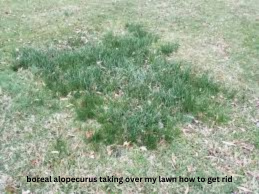Boreal Alopecurus, commonly known as the northern foxtail, is a persistent and invasive grass species that can take over your lawn, overshadowing the more desirable, manicured turfgrass. This article boreal alopecurus taking over my lawn how to get rid delves deep into understanding Boreal Alopecurus, its characteristics, why it thrives in certain environments, and most importantly, how to effectively rid your lawn of this unwelcome guest.
Understanding Boreal Alopecurus: The Unwelcome Lawn Invader
Boreal Alopecurus is distinguished by its rapid growth and ability to dominate other grass species through a mechanism known as allelopathy. This means it releases chemicals into the soil that inhibit the growth of surrounding plants, giving itself a survival advantage. This grass is not only tough but also adapts quickly to varying conditions, making it a formidable foe for any lawn enthusiast.
Identifying the Culprit: Characteristics of Boreal Alopecurus
Recognizing Boreal Alopecurus is the first step towards tackling it. This grass species features a dense, fibrous root system, and its leaves are typically longer and coarser than those of regular lawn grass. The seed heads resemble a fox’s tail, hence the name “foxtail.”
The Dangers of Boreal Alopecurus in Your Lawn
Boreal Alopecurus poses several risks to your lawn that go beyond mere aesthetic issues. This invasive grass species can rapidly colonize and dominate a lawn, leading to several detrimental effects:
Competition for Resources:
Boreal Alopecurus is highly competitive, aggressively seizing water, nutrients, and sunlight from surrounding plants. This aggressive growth can starve your desirable lawn grasses, causing them to weaken and die off, leaving unsightly bare patches.
Soil Degradation:
The root system of Boreal Alopecurus can alter the soil structure. Its roots may produce chemicals that inhibit the growth of other plants, affecting soil health and reducing biodiversity in your lawn’s ecosystem.
Pest and Disease Harbor:
The thick and often matted growth of Boreal Alopecurus provides an ideal environment for pests and diseases to thrive. This can lead to a higher incidence of lawn pests and fungal diseases, which may spread to other parts of your garden.
Water Management Issues:
Due to its dense growth, areas infested with Boreal Alopecurus can suffer from poor water penetration. This can lead to runoff issues and make your lawn more susceptible to drought stress.
Aesthetic Impact:
Visually, Boreal Alopecurus can be a nuisance. It disrupts the uniformity of your lawn with its coarse texture and uneven growth patterns, impacting the overall curb appeal of your property.
The Allelopathic Advantage: Why Boreal Alopecurus Thrives
The science behind allelopathy explains much about the invasive success of Boreal Alopecurus. By releasing biochemicals into the soil, it effectively suppresses the competition, often leaving homeowners puzzled as to why certain parts of their lawn are failing.
Strategies for Eradicating Boreal Alopecurus
Combatting Boreal Alopecurus requires a multi-pronged approach:
- Manual Removal: This is effective for small infestations. Uproot the crops ensuring you remove the entire origin program to avoid regrowth.
- Mowing Tactics: Regular mowing can help weaken the grass by cutting off its ability to photosynthesize efficiently. It’s crucial to mow at the right height to stress Boreal Alopecurus without harming the lawn.
- Soil Solarization: This method involves covering the affected area with a clear plastic sheet during the hot months, using the sun’s heat to kill the seeds and roots.
- Organic Herbicides: Products based on natural acids or oils can help control Boreal Alopecurus without the environmental impact of chemical herbicides.
- Chemical Control: As a last resort, selective herbicides can target Boreal Alopecurus without affecting other grasses. However, this should be used judiciously and preferably under professional guidance.
Preventing Future Invasions: Building a Resilient Lawn
After eradicating Boreal Alopecurus, focus on lawn health to prevent re-invasion. This includes proper fertilization, regular watering, and overseeding with competitive grass species that can withstand invasive pressures.
Natural Ways to Control Boreal Alopecurus
Integrating beneficial microorganisms into the soil can enhance its health and resilience. These microorganisms can break down the allelopathic chemicals and improve nutrient availability for the lawn.
The Role of Beneficial Microorganisms in Lawn Health
Promoting a biodiverse ecosystem within your lawn is crucial. Beneficial fungi and bacteria can play a significant role in maintaining a healthy balance in the soil, making it less hospitable to invaders like Boreal Alopecurus.
Conclusion boreal alopecurus taking over my lawn how to get rid
While Boreal Alopecurus poses a significant challenge, it is not insurmountable. With the right knowledge and tools, you can reclaim your lawn, restoring it to its lush, green glory. Remember, the key to success lies in persistence and maintaining the health of your lawn through both preventive and active measures.


